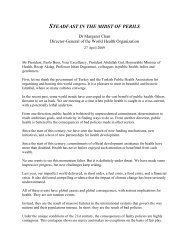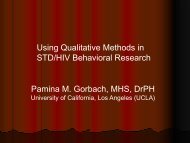The Evolution of HTA in Emerging Markets Health-Care ... - TREE
The Evolution of HTA in Emerging Markets Health-Care ... - TREE
The Evolution of HTA in Emerging Markets Health-Care ... - TREE
Create successful ePaper yourself
Turn your PDF publications into a flip-book with our unique Google optimized e-Paper software.
OHE Consult<strong>in</strong>g Report for PhRMA<br />
5 January 2011<br />
8 <strong>Health</strong> <strong>Care</strong> systems and <strong>HTA</strong> <strong>in</strong> Brazil, Ch<strong>in</strong>a and Taiwan<br />
8.1 Sources <strong>of</strong> Information<br />
Information relat<strong>in</strong>g to healthcare systems and <strong>HTA</strong> use <strong>in</strong> the three countries, Brazil, Ch<strong>in</strong>a and<br />
Taiwan, was obta<strong>in</strong>ed us<strong>in</strong>g a number <strong>of</strong> different processes. <strong>The</strong>se are outl<strong>in</strong>ed below. Throughout,<br />
local <strong>in</strong>formation relates to that published with<strong>in</strong> the country.<br />
1) A number <strong>of</strong> literature searches were performed us<strong>in</strong>g PUBMED, Google and Google scholar.<br />
Key words utilised <strong>in</strong> these searches <strong>in</strong>cluded: (“<strong>Health</strong> technology assessment” OR “<strong>HTA</strong>”)<br />
and (Brazil OR Ch<strong>in</strong>a OR Taiwan). <strong>The</strong> article section based on these results was then ref<strong>in</strong>ed<br />
us<strong>in</strong>g the title and filter<strong>in</strong>g out studies that were disease or drug-‐specific. <strong>The</strong>se searches<br />
were supplemented by review<strong>in</strong>g a number <strong>of</strong> key papers identified by the steer<strong>in</strong>g group or<br />
based on the knowledge <strong>of</strong> team members.<br />
2) Key health statistics, such as healthcare spend per capita, can help to complement the<br />
literature <strong>in</strong> creat<strong>in</strong>g a broad picture <strong>of</strong> the healthcare system <strong>of</strong> a country. As such, a<br />
number <strong>of</strong> statistics for each <strong>of</strong> the countries was identified us<strong>in</strong>g key <strong>in</strong>ternational data<br />
sources, primarily WHOSIS and WHO global health <strong>in</strong>dicators. Google searches were also<br />
performed. Where <strong>in</strong>formation was not available through <strong>in</strong>ternational sources or where the<br />
<strong>in</strong>ternationally published data conflicted with the local <strong>in</strong>formation, it was supplemented by<br />
the local team members, with preference given to the locally published data, where this was<br />
considered to have a greater degree <strong>of</strong> accuracy. <strong>The</strong> f<strong>in</strong>d<strong>in</strong>gs are <strong>in</strong>cluded <strong>in</strong> Table 2<br />
3) In order to ga<strong>in</strong> a more <strong>in</strong>-‐depth and up-‐to-‐date understand<strong>in</strong>g <strong>of</strong> the healthcare systems<br />
and <strong>HTA</strong> processes <strong>in</strong> these countries, a number <strong>of</strong> local experts <strong>in</strong> the field were identified,<br />
and local team members utilised to conduct <strong>in</strong>terviews with these experts. A scope for the<br />
<strong>in</strong>terviews was formulated by consider<strong>in</strong>g the <strong>in</strong>formation available <strong>in</strong> the <strong>in</strong>ternational<br />
literature and ensur<strong>in</strong>g that the scope would be sufficient to form a broad picture <strong>of</strong> the<br />
healthcare systems <strong>in</strong> conjunction with <strong>HTA</strong> processes for the three countries. To help<br />
ensure that the <strong>in</strong>terview scope would cover the key features and provide sufficient<br />
<strong>in</strong>formation to classify <strong>HTA</strong> with<strong>in</strong> that country, available <strong>in</strong>formation based on the<br />
<strong>in</strong>ternational literature was utilised to complete a pre-‐exist<strong>in</strong>g classification system<br />
(Chalkidou, 2009), and questions were <strong>in</strong>corporated that would ensure this classification<br />
could be fully completed with the completed <strong>in</strong>terview scripts. See Appendix 4 for the<br />
<strong>in</strong>terview scope. In total, six <strong>in</strong>terviews <strong>of</strong> local experts were performed by the local team<br />
members. <strong>The</strong> local experts were identified by a process <strong>of</strong> consultation between team<br />
members, <strong>in</strong>clud<strong>in</strong>g the local members <strong>of</strong> the team, with valuable <strong>in</strong>put from members <strong>of</strong><br />
the steer<strong>in</strong>g group. Additional potential experts were identified based on the key<br />
<strong>in</strong>ternational literature. See Appendix 5 for a list <strong>of</strong> those <strong>in</strong>terviewed. See Appendix 6 for a<br />
summary <strong>of</strong> the f<strong>in</strong>d<strong>in</strong>gs from the <strong>in</strong>terviews.<br />
5) In addition to the <strong>in</strong>ternational literature identified as described <strong>in</strong> 1), local/grey literature<br />
also provides useful <strong>in</strong>sights <strong>in</strong>to the healthcare systems and <strong>HTA</strong> processes for these<br />
countries.<br />
47








